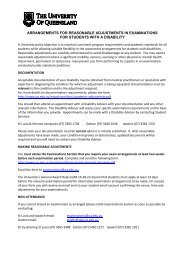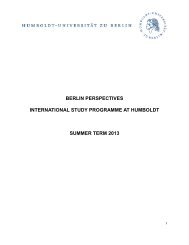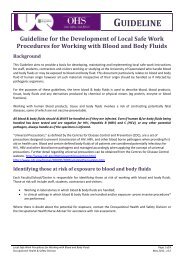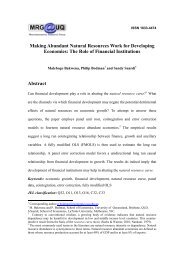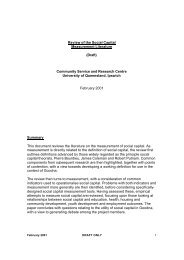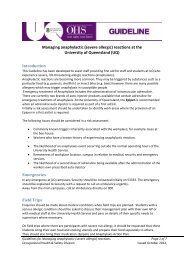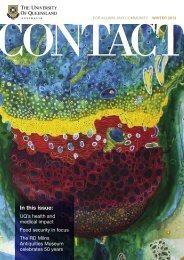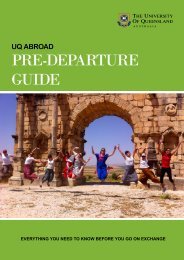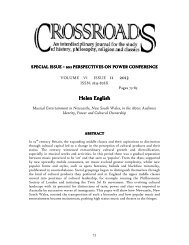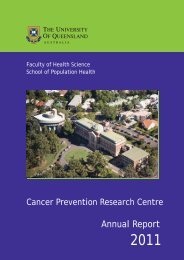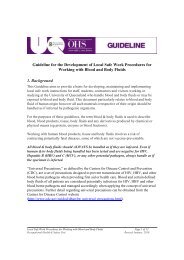Mechanical disruption of seagrass in the digestive tract of the dugong
Mechanical disruption of seagrass in the digestive tract of the dugong
Mechanical disruption of seagrass in the digestive tract of the dugong
Create successful ePaper yourself
Turn your PDF publications into a flip-book with our unique Google optimized e-Paper software.
<strong>Mechanical</strong> <strong>disruption</strong> <strong>of</strong> <strong>seagrass</strong> by <strong>the</strong> <strong>dugong</strong><br />
J. M. Lanyon and G. D. Sanson<br />
Table 4 Effect <strong>of</strong> gr<strong>in</strong>d<strong>in</strong>g on particle size distributions expressed as median (M) particle size (mm) <strong>of</strong> <strong>the</strong> leaf fraction <strong>of</strong> five dried <strong>seagrass</strong>es and<br />
three terrestrial grasses<br />
Median (M) particle size (mm)<br />
Breakability NDF (% dm)<br />
0 gr<strong>in</strong>ds 100 gr<strong>in</strong>ds 500 gr<strong>in</strong>ds Index Rank Mean SE<br />
Seagrass<br />
Halophila ovalis 287.6 164.7 55.9 231.1 1 42.6 0.9 (n=5)<br />
Halodule un<strong>in</strong>ervis (n) 220.6 185.9 69.2 151.4 2 50.8 0.7 (n=5)<br />
Halodule un<strong>in</strong>ervis (b) 230.1 190.1 104.4 125.7 3 54.2 1.1 (n=5)<br />
Cymodocea serrulata 161.5 114.4 70.9 90.6 5 52.5 0.9 (n=5)<br />
Zostera capricorni 155.5 131.6 73.9 81.6 6 62.6 1.7 (n=5)<br />
Terrestrial grass<br />
Triticum aestivum 214.5 166.2 93.8 120.7 4 42.0 (n=1)<br />
Koeleria setacea 193.7 148.4 146.1 47.6 8 57.0 (n=1)<br />
Erharta erecta 176.0 124.8 106.3 69.7 7 62.8 (n=1)<br />
Number <strong>of</strong> gr<strong>in</strong>ds refers to <strong>the</strong> number <strong>of</strong> gr<strong>in</strong>ds after mill<strong>in</strong>g. Grasses are assigned a breakability rank accord<strong>in</strong>g to <strong>the</strong>ir breakability <strong>in</strong>dex, from<br />
most breakable (rank 1) through to least breakable (rank 8). NDF, neutral detergent fibre level expressed as a percentage <strong>of</strong> dry matter.<br />
Breakability <strong>in</strong>dex<br />
250<br />
200<br />
150<br />
100<br />
50<br />
0<br />
30 35 40 45 50 55 60 65<br />
Percentage NDF<br />
components. The nature <strong>of</strong> <strong>the</strong>se leached materials was not<br />
<strong>in</strong>vestigated here.<br />
Fibre analysis<br />
There was a significant difference <strong>in</strong> fibre levels between<br />
<strong>seagrass</strong> species (F=1226.76; d.f.=1, 49; Po0.001). The<br />
NDF content <strong>of</strong> <strong>seagrass</strong> leaves ranged between<br />
42.64 0.9% dry matter <strong>in</strong> Halophila ovalis to 62.6 1.7%<br />
<strong>in</strong> Z. capricorni (Table 4). The NDF content <strong>of</strong> Halophila<br />
ovalis was comparable to that <strong>of</strong> young wheat T. aestivum.<br />
Zostera capricorni had NDF levels that were comparable to<br />
<strong>the</strong> two mature terrestrial grasses.<br />
Discussion<br />
Particle size reduction<br />
Masticatory efficiency<br />
H. ovalis<br />
C. serrulata<br />
H. un<strong>in</strong>ervis (n)<br />
H. un<strong>in</strong>ervis (b)<br />
Z. capricorni<br />
Figure 8 Relationship between breakability <strong>in</strong>dex and mean neutral<br />
detergent fibre (NDF) level (% dry matter; n=5) <strong>of</strong> <strong>the</strong> leaf fraction <strong>of</strong><br />
each <strong>of</strong> five <strong>seagrass</strong> species.<br />
Seagrasses <strong>in</strong> <strong>the</strong> stomach <strong>of</strong> <strong>the</strong> <strong>dugong</strong> were well macerated,<br />
presumably by <strong>the</strong> mouthparts. The mean particle<br />
sizes <strong>of</strong> <strong>the</strong> stomach contents <strong>of</strong> <strong>dugong</strong>s <strong>in</strong> this study were<br />
comparable to those <strong>of</strong> <strong>dugong</strong>s from elsewhere (Marsh<br />
et al., 1999). Masticatory or occlusal efficiency (characterized<br />
by production <strong>of</strong> a greater number <strong>of</strong> small particles)<br />
does not appear to alter <strong>in</strong> a manner that is consistent with<br />
age nor with <strong>the</strong> occlusal surface area <strong>of</strong> <strong>the</strong> mouthparts <strong>of</strong><br />
<strong>the</strong> <strong>dugong</strong>. Dugongs with greater occlusal surfaces did not<br />
have greater occlusal efficiency. Fur<strong>the</strong>r, particle size distribution<br />
<strong>of</strong> <strong>the</strong> stomach contents did not appear to correlate<br />
with <strong>the</strong> composition <strong>of</strong> <strong>the</strong> diet <strong>in</strong> terms <strong>of</strong> <strong>seagrass</strong><br />
species. However, determ<strong>in</strong><strong>in</strong>g <strong>the</strong> dietary composition for<br />
<strong>dugong</strong>s based on stomach contents was problematic because<br />
most <strong>of</strong> <strong>the</strong> <strong>in</strong>gesta were too f<strong>in</strong>ely ground to be<br />
identifiable.<br />
In contrast, variation <strong>in</strong> faecal particle size distributions<br />
could be attributed to species composition <strong>of</strong> <strong>the</strong> diet. The<br />
only <strong>seagrass</strong> species that could be consistently identified <strong>in</strong><br />
<strong>the</strong> faeces was Z. capricorni. Preen (1993) also found<br />
identifiable Z. capricorni <strong>in</strong> <strong>the</strong> faeces but could not dist<strong>in</strong>guish<br />
o<strong>the</strong>r species. Ra<strong>the</strong>r than <strong>in</strong>dicate that Z. capricorni<br />
was more prevalent <strong>in</strong> <strong>the</strong> <strong>dugong</strong>’s diet, this result could<br />
equally <strong>in</strong>dicate that Z. capricorni was less digestible. Zostera<br />
capricorni was present as larger particles so that <strong>the</strong><br />
resultant particle distribution tended to have a greater<br />
median particle size than those faecal samples <strong>in</strong> which<br />
Z. capricorni was absent. Zostera capricorni is one<br />
<strong>of</strong> <strong>the</strong> <strong>seagrass</strong>es least preferred by <strong>dugong</strong>s (Preen,<br />
1993).<br />
In o<strong>the</strong>r faecal samples, <strong>the</strong> largest particle size class (i.e.<br />
41.6 mm) comprised vascular bundles only. These were<br />
also found <strong>in</strong> <strong>dugong</strong> faeces exam<strong>in</strong>ed by Anderson &<br />
Birtles (1978). O<strong>the</strong>rwise, <strong>dugong</strong> faeces were uniformly<br />
very f<strong>in</strong>e, which was unusual compared with <strong>the</strong> faeces <strong>of</strong><br />
o<strong>the</strong>r herbivores that generally have a higher proportion<br />
<strong>of</strong> larger particulate matter. Bertram & Bertram (1968,<br />
p. 389) also remarked on <strong>the</strong> ‘smooth, greenish<br />
clay-like faeces’ <strong>of</strong> <strong>the</strong> <strong>dugong</strong>. The uniformity <strong>of</strong> <strong>the</strong><br />
faeces may be accounted for by considerable postoral<br />
particle size reduction <strong>of</strong> <strong>seagrass</strong> <strong>in</strong>gesta. Interest<strong>in</strong>gly,<br />
Bjorndal (1979) has remarked on <strong>the</strong> well-digested appearance<br />
<strong>of</strong> faeces <strong>of</strong> green turtles feed<strong>in</strong>g on <strong>seagrass</strong>es.<br />
284<br />
Journal <strong>of</strong> Zoology 270 (2006) 277–289 c 2006 The Authors. Journal compilation c 2006 The Zoological Society <strong>of</strong> London




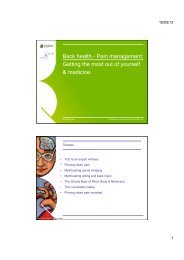
![Recycling [ PDF, 62KB ] - University of Queensland](https://img.yumpu.com/51805185/1/184x260/recycling-pdf-62kb-university-of-queensland.jpg?quality=85)
